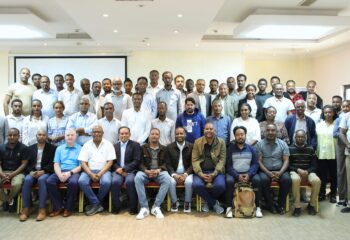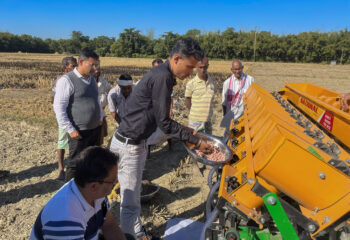
West Africa and the Sahel, a region where millions of smallholder farmers struggle with low yields and soil degradation, faces the looming threat of food insecurity. The delicate balance of these communities is further disrupted by climate shifts, which compounds the issue of poor soil health. However, digital soil health and fertility maps offer a technological innovation with the potential to transform agriculture in the region.
These cutting-edge tools offer precise, data-driven solutions to improve soil management, boost productivity, and enhance climate resilience. By integrating vast datasets from soil samples, satellite imagery, and geospatial analysis, digital soil maps provide a comprehensive understanding of soil health across the region.
This granular level of insight empowers farmers to make informed decisions, such as selecting appropriate crop varieties, optimizing planting schedules, and tailoring irrigation strategies to local conditions. Tools such as AgWise, which leverage these maps, deliver localized advice directly to farmers, enabling them to mitigate climate risks and increase their yields.
“The release of improved digital soil maps is not just a technological breakthrough – it’s a testament to the collective resolve of governments, researchers, and farmers to transform agriculture in West Africa and the Sahel.”
Bernard Vanlauwe, Deputy Director General of Research for Development at the International Institute of Tropical Agriculture (IITA)

Beyond climate resilience, digital soil maps contribute to environmental sustainability by minimizing the overuse of fertilizers. By identifying specific nutrient deficiencies, farmers can apply precise amounts of fertilizer, reducing environmental harm such as soil acidification and water contamination. This precision farming approach promotes sustainable land management practices, preserving soil health for future generations.
The economic impact of digital soil maps is equally significant. By adopting data-driven practices, farmers can achieve yield increases of up to 40% and profit gains of up to 20%. This translates into improved livelihoods for individual farmers and, on a larger scale, reduced food import costs for nations, bolstering regional food security.
The development of digital soil maps relies on advanced technologies, including artificial intelligence and machine learning, which analyze complex datasets to generate detailed and accurate maps. These tools are complemented by mobile apps and digital platforms that provide user-friendly access to soil data and recommendations for farmers and extension agents. Collaborative efforts between organizations such as ISRIC – World Soil Information, iSDAsoil, and the Regional Hub for Fertilizer and Soil Health for West Africa and the Sahel (the Hub) contribute to the accuracy and reach of these maps.

“The release of improved digital soil maps is not just a technological breakthrough – it’s a testament to the collective resolve of governments, researchers, and farmers to transform agriculture in West Africa and the Sahel. Fertile soil is the foundation of food security, and these maps bring us closer to that goal,” remarked Bernard Vanlauwe, Deputy Director General of Research for Development at the International Institute of Tropical Agriculture (IITA) and chair of the Hub consortium steering committee.
While the potential of digital soil maps is immense, challenges remain; ensuring high-quality, standardized data collection and sharing is crucial. Unified databases and partnerships between governments, research institutions, and the private sector are essential to fill data gaps. Additionally, investments in digital infrastructure and capacity-building programs are necessary to enable stakeholders, from policymakers to farmers, to utilize these maps effectively.
The African Union’s 10-Year Africa Fertilizer and Soil Health Action Plan recognizes the importance of multi-stakeholder partnerships to drive investments in soil management. The Hub’s strategy is therefore framed by the priorities of the 2023 Fertilizer and Soil-Health Roadmap and the Nairobi Declaration from the 2024 Africa Fertilizer and Soil Health Summit.
Governments, donors, and private-sector stakeholders have a crucial role to play in realizing the full potential of digital soil maps. By investing in digital infrastructure and capacity building, implementing policies that incentivize the use of these tools, and fostering regional collaboration, they can contribute to a future in which West Africa and the Sahel achieve resilient, sustainable, and inclusive agricultural growth, ensuring food security and prosperity for generations to come.

As the updated digital soil maps are set to launch in early 2025, the Hub is actively working on expanding mapping efforts, enhancing data accuracy, and supporting the development and adoption of climate-smart agronomy tools such as AgWise. AgWise is a freely available, open-source tool that provides data-driven, localized, and climate-specific agronomic recommendations. It combines agronomic and geospatial datasets from field trials, market analyses, and open data sources to deliver tailored advice on optimal planting times, cultivar selection, fertilizer types and quantities, and good agronomic practices.
Currently supporting eight crops – including cassava, maize, potato, rice, and wheat – in key African countries, AgWise integrates soil, weather, and satellite data from sources such as ISRIC to contextualize recommendations for specific growing conditions. Designed to empower smallholder farmers, the platform offers actionable insights to improve productivity and profitability, while its open-source nature enables further development by the global agricultural community.
“Agricultural productivity and soil resilience in West Africa and the Sahel aren’t just about food security – they are foundational to economic stability and climate resilience,” noted Vanlauwe further. As we approach the release of the new maps, the promise of data-driven agriculture in West Africa has never been more tangible.
About the Regional Hub for Fertilizer and Soil Health for West Africa and the Sahel:
The Hub is a collaborative effort initiated at the Africa Fertilizer and Soil Health Summit in Nairobi on May 8, 2024, focusing on combating soil health decline in the region. It was launched in IITA headquarters in Ibadan, Nigeria, in June 2024 and brings together key stakeholders, including IITA, OCP Africa, the African Plant Nutrition Institute (APNI), University Mohammed VI Polytechnic (UM6P), the International Fertilizer Development Center (IFDC), Accelerating the Impacts of CGIAR Climate Research for Africa (AICCRA), Economic Community of West African States (ECOWAS), and the World Bank.
The impact of the Hub is magnified by the collaboration of key partners, each contributing its unique strength and invites partnerships with other organizations, research institutions, and private sector entities to achieve a thriving agricultural future in the region.




